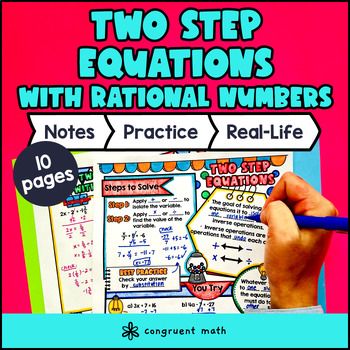Want more ideas and freebies?
Get my free resource library with digital & print activities—plus tips over email.
Join for Free Resources →
$4.25
Ever wondered how to teach two-step equations with rational numbers in an engaging way to your 7th and 8th grade students?
In this lesson plan, students will learn about solving two-step equations with rational numbers and their real-life applications. Through artistic and interactive guided notes, check for understanding questions, a doodle and color by number activity, and a maze worksheet, students will gain a comprehensive understanding of solving two-step equations with rational numbers.
The lesson culminates with a real-life example that explores how this math skill can be used in practical situations.

$4.25
After this lesson, students will be able to:
Before this lesson, students should be familiar with:
As a hook, ask students why it is important to be able to solve two-step equations with rational numbers in real-life situations. Refer to the last page of the guided notes as well as the FAQs below for ideas.
Use the first page of the guided notes to introduce the concept of two-step equations and explain how to solve them using inverse operations. Walk through the key points of the topic, including the steps to isolate the variable, solve for its value, check the solutions through substitution. Refer to the FAQ below for a walk-through on this, as well as ideas on how to respond to common student questions.
Based on student responses, reteach concepts that students need extra help with. If your class has a wide range of proficiency levels, you can pull out students for reteaching, and have more advanced students begin work on the practice exercises.
Have students practice solving two-step equations with rational numbers using the practice worksheet provided in the resource. The worksheet includes a problem set (page 2 of guided notes), a maze (page 3 of guided notes), and color by code activity (page 4 of guided notes)
Walk around the classroom to answer any questions that students may have while they work on the practice worksheet.
For students who finish the practice worksheet quickly, they can move on to the real-life application activity included in the resource. This activity asks students to read and write about real-life uses of the math skill they have learned. You can assign this activity as homework for the remainder of the class if necessary.
Use the last page of the guided notes called "real life applications" to bring the class back together, and introduce the concept of real-life applications of solving two-step equations with rational numbers. Explain to the students that solving equations is not just an abstract mathematical concept, but it has practical applications in various real-world situations.
Students read the short passage about real life applications of two step equations and reflect on their learning using the guided notes.
If you’re looking for digital practice for solving and graphing two-step inequalities, try my Pixel Art activities in Google Sheets. Every answer is automatically checked, and correct answers unlock parts of a mystery picture. It’s incredibly fun, and a powerful tool for differentiation.
Here are 2 activities to explore:
A fun, no-prep way to practice multi-step equations with variables on one side and both sides is with Doodle Math — they’re a fresh take on color by number or color by code. It includes multiple levels of practice, perfect for a review day or sub plan.
Here are 2 activities to try:
Two-step equations are algebraic equations that require two steps to solve. They involve two operations - addition/subtraction and multiplication/division.
To solve a two-step equation with rational numbers, follow these steps:
Certainly! Here's an example: Example: Solve the equation 3x - 5 = 7
The solutions to a two-step equation can be any rational numbers, including integers, decimals, and fractions.
While there are no specific tricks or shortcuts, it is helpful to remember these key steps to solve two-step equations:
Yes, here are some common mistakes to avoid:
To check if your solution is correct, substitute the value you found for the variable back into the original equation and see if both sides are equal. If they are, your solution is correct.
Two-step equations with rational numbers can be applied in various real-life scenarios such as calculating expenses, solving distance-speed-time problems, or determining the sales price after a discount. It helps in understanding and solving real-world mathematical problems accurately.
Get my free resource library with digital & print activities—plus tips over email.
Join for Free Resources →